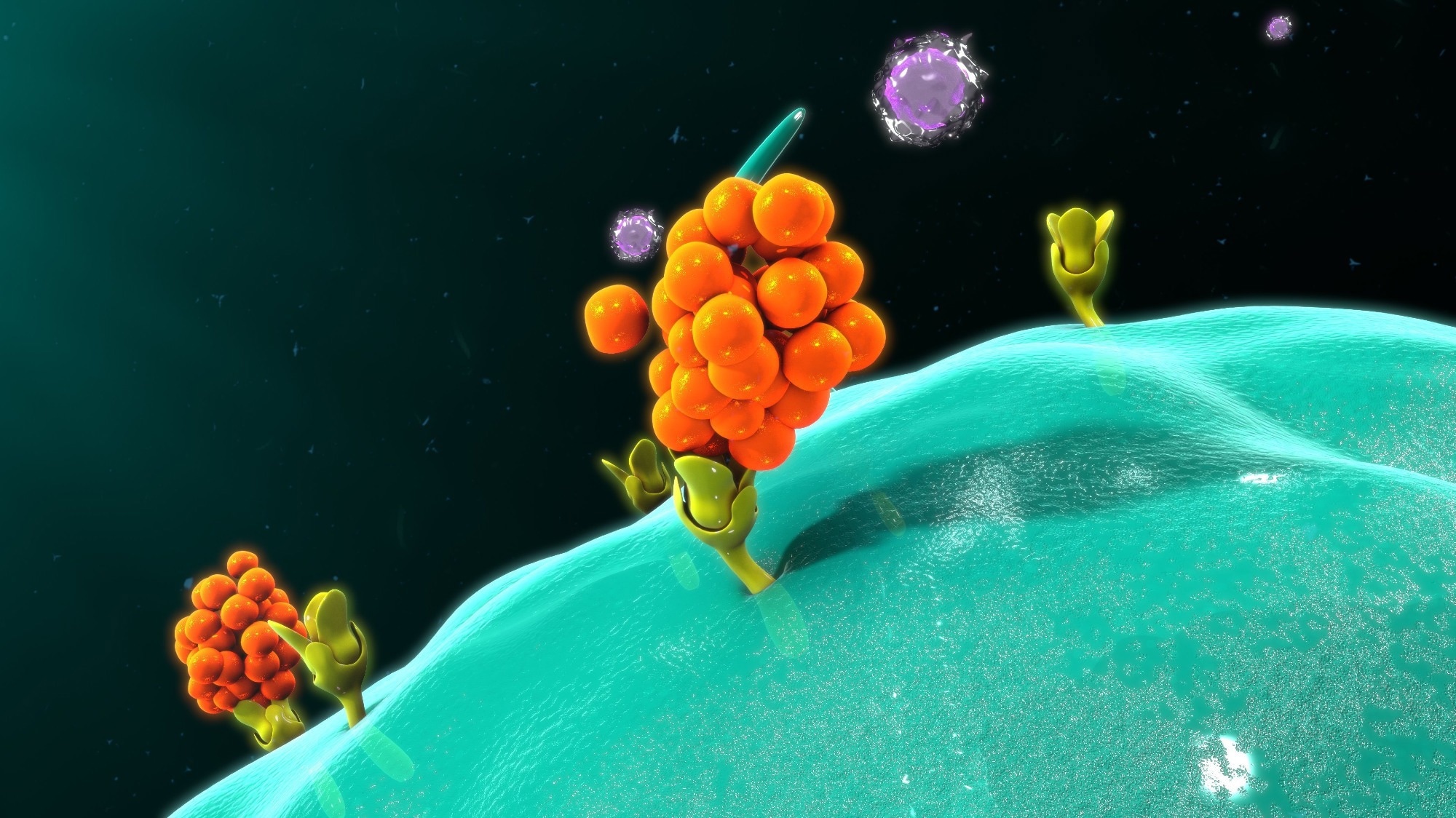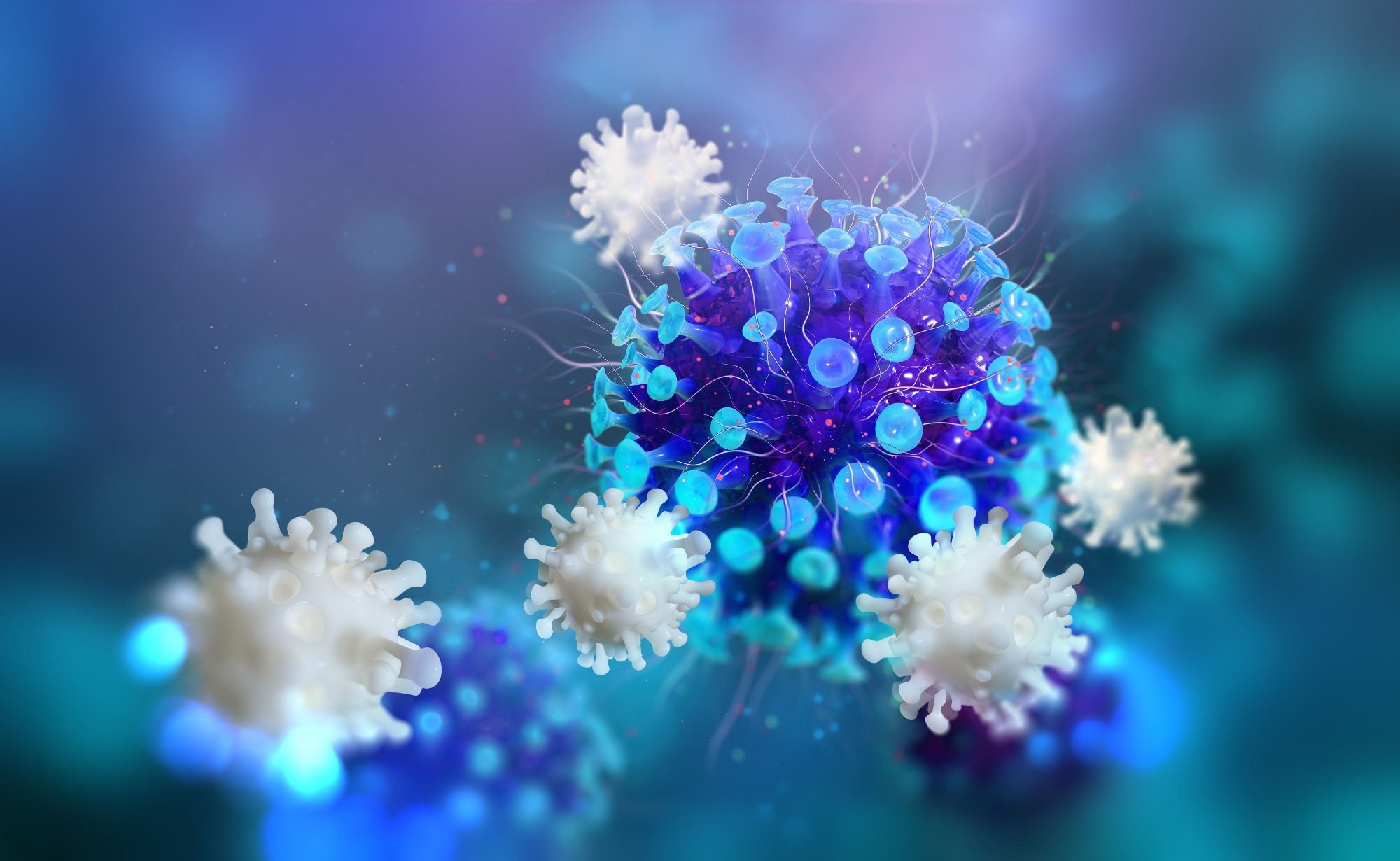Introduction
Leukocytes
Extravasation
Chemokine-chemokine receptor interaction
COVID-19
References
Further reading
Introduction
Chemokines are a large subfamily of small cell signaling proteins or cytokines, which in conjunction with their G protein-coupled receptors (GPCR), govern the process of cell migration.
The role of certain chemokines is considered pro-inflammatory, with the proteins being recruited to an infection site during an immune response, while other chemokines are thought to have a homeostatic role, controlling cell migration as part of normal tissue growth and maintenance. Cell migration is crucial to maintaining proper tissue function during development and organogenesis. Cells secrete chemokines to induce chemotaxis in nearby cells, a process that directs cell movement according to the presence of chemicals in their surrounding environment. Chemokines initiate directional cell movement through actin reorganization.
 Image Credit: sciencepics / Shutterstock
Image Credit: sciencepics / Shutterstock
Leukocytes
During pathological conditions, such as inflammatory neurological disorders and viral infections, chemokines are primarily responsible for recruiting white blood cells (WBCs) or leukocytes. The presence of a microbe or a foreign body triggers the release of chemokines that direct immune cells to migrate toward the site of infection. For example, chemokines induce neutrophils to leave blood vessels and migrate towards the site of infection where the invading body is present. Monocytes and immature dendritic cells are recruited at a later stage. Chemokines are therefore also referred to as chemotactic cytokines.
 White blood cells attack infected cells. Image Credit: Yurchanka Siarhei / Shutterstock
White blood cells attack infected cells. Image Credit: Yurchanka Siarhei / Shutterstock
Extravasation
Furthermore, chemokines play a role in tissue extravasation and functional modulation of cells. Extravasation is a process wherein leukocytes migrate from the tissues to the blood and from the lymphatic vessels back into the tissues. The binding of chemokines to extracellular matrix glycosaminoglycans (GAGs), located on the surface of cells, such as endothelial cells, establishes a chemokine gradient that allows directional movement of leukocytes. A chemokine gradient is a kind of road map for the migrating cells, guiding them towards their final destination. Since GAGs regulate the amount of free and bound chemokine, they influence the formation of chemokine gradients. Furthermore, studies have demonstrated that the absence of GAGs impairs the chemotactic ability of chemokines, suggesting GAGs could be potential therapeutic targets for the modulation of leukocyte recruitment.
Cells also modulate their functioning via chemokines. First, they bind the vessel endothelium via activation of selectins. Next, they bind the endothelium via activation of integrins, which undergo rapid conformational change leading to cell arrest, a mechanism that allows cells to cross the endothelium. Other functions of chemokines include leukocyte degranulation and angiogenesis, or angiostasis.
Chemokines are small in size, with a molecular weight of around 8 to 10 kilodaltons (kDa). They share structural similarities and usually contain four cysteine (Cys) residues, which gives them their three-dimensional shape. Historically, they have been known by different names, including the SIS family, SIG family, or SCY family of cytokines, the intercrines, and the platelet factor-4 superfamily. Chemokines are present in all vertebrate animals as well as in some microbes, including bacteria and viruses, but none have yet been identified in other non-vertebrates.
Chemokine-chemokine receptor interaction
The actions of chemokines are controlled by their respective receptors (members of the GPCR family), which, when activated, can uncouple from intracellular G proteins, internalize, and degrade the ligand. In mammals, 48 chemokines and 19 types of chemokine receptors have been identified so far, which are predominantly located on the surface of leukocytes.
Not all chemokine binding proteins induce cell migration, as exemplified by the Duffy antigen-related chemokine receptor (DARC), chemokine centryx-chemokine receptor (CXC-CKR), and CXCR7 receptors. They do not initiate the GPCR signaling pathway and fail to increase cytoplasmic calcium levels, and thus their activation does not result in chemotaxis. Instead, they regulate the levels of their respective chemokine ligands by internalizing chemokines and then degrading them or by manipulating the levels of expression of signaling chemokine receptors. DARC specifically is thought to eliminate chemokines from blood.
Chemokine receptors are designated according to the type of chemokine(s) they bind, followed by R for receptor and a number indicating the order of discovery. Chemokine receptors belong to the large family of seven trans-membrane domain receptors that couple to hetero-trimeric GTP-binding proteins (G-proteins). Currently, the human system comprises six CXCRs, 10 CCRs, one CX3CR, and one XCR chemokine.
Chemokines play essential roles in the pathogenesis of several respiratory diseases, including allergic asthma and acute respiratory distress syndrome, as well as viral and bacterial infections, allograft rejection, and cancer. In addition, chemokines are multifunctional mediators of cellular communication in the healthy and developing nervous system. The term neurochemokine describes chemokine actions, such as neurotransmission and facilitation of neuroimmune and neuroglia interactions. Neurons, macroglia, and microglia can all produce chemokines and constitutively express a variety of chemokine receptors. In pathological situations, such as inflammatory neurological disorders, chemokines play a fundamental role in activating leukocyte migration to the nervous tissues resulting in severe local damage and the onset of debilitating neurological deficits.
However, no known chemokine system is singularly responsible for the recruitment of effector cells to inflammatory sites. Thus, multiple chemokines have been identified in the synovial fluid and inflamed tissue of joints with rheumatoid arthritis and other chronic inflammatory diseases. The steady influx of macrophages and T and B cells is also maintained by the continuous production of corresponding chemokines. In fact, chemokines define ‘‘migratory’’ T cell subsets.
COVID-19
In severe coronavirus disease 2019 (COVID-19) cases, a cytokine storm develops that is associated with increased levels of chemokines CCL2 and CCL7, and to a lesser extent CCL3, CCL4, CCL5, and CXCL10, which recruit inflammatory monocytes, neutrophils, and CD8þ cytotoxic T cells. However, studies have not elucidated how these chemokines contribute to the recruitment of different leukocytes during the disease progression. Nevertheless, these chemokines might be potential therapeutic targets or biomarkers of COVID-19 outcomes.
What Is a Cytokine Storm?
Studies have shown three sites in chemokines are essential for their adequate functioning.
- N loop region enabling initial receptor contact
- Matrix fixation site in the COOH terminal a-helix or core structure,
- NH2-terminus, which interacts with the chemokine binding pocket formed by the trans-membrane regions of the chemokine receptor.
To summarize, the pleiotropy and redundancy of chemokines during ligand-receptor interactions make it challenging to establish their role in various disease conditions. In addition, chemokine promiscuity, whereby an individual chemokine can bind to several receptors, and each receptor can bind multiple chemokine ligands, has made it difficult to determine their functions.
Further Reading